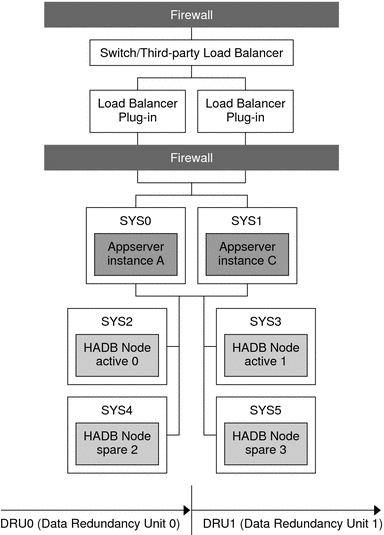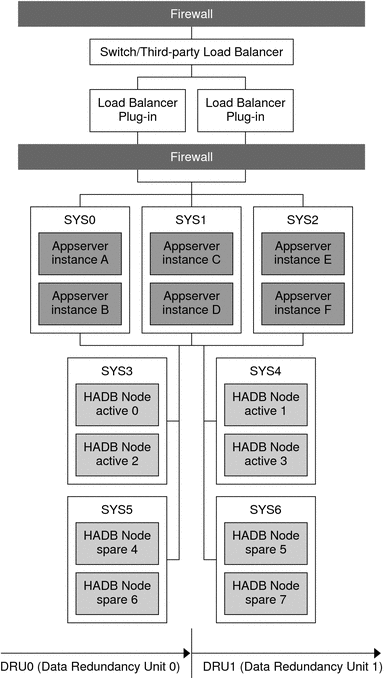Separate Tier Topology
In this topology, Application Server instances and the HADB nodes are on different machines (hence the name separate tier).
This topology requires more hardware than the co-located topology. It might be a good fit if you have different types of machines—you can allocate one set of machines to host Application Server instances and another to host HADB nodes. For example, you could use more powerful machines for the Application Server instances and less powerful machines for HADB.
Example Configuration
The following figure illustrates the separate tier topology.
Figure 3–3 Example Separate Tier Topology

In this topology, machine SYS0 hosts Application Server instance A and machine SYS1 hosts Application Server instance B. These two instances form a cluster that persists session information to the two DRUs:
-
DRU0 comprises two machines, SYS2 and SYS4. HADB node active 0 is on machine SYS2 and the HADB node spare 2 is on machine SYS4.
-
DRU1 comprises two machines, SYS3 and SYS5. HADB node active 1 is on machine SYS3 and the HADB node spare 3 on machine SYS5.
All the nodes on a DRU are on different machines, so that even if one machine fails, the complete data for any DRU continues to be available on other machines.
Variation of Separate Tier Topology
A variation of the separate tier topology is to increase the number of Application Server instances by adding more machines horizontally to the configuration. For example, add another machine to the example configuration by creating a new Application Server instance. Similarly, increase the number of HADB nodes by adding more machines to host HADB nodes. Recall you must add the HADB nodes in pairs with one node for each DRU.
Variation of Separate Tier Topology illustrates this configuration.
Figure 3–4 Variation of Separate Tier Topology

In this configuration, each machine hosting Application Server instances has two instances. There are thus a total of six Application Server instances in the cluster.
HADB nodes are on machines SYS3, SYS4, SYS5, and SYS6.
DRU0 comprises two machines:
-
SYS3, which hosts HADB node active 0 and HADB node active 2.
-
SYS5, with HADB node spare 4 and HADB node spare 6.
DRU1 comprises two machines:
-
SYS4, which hosts HADB node active 1 and HADB node active 3.
-
SYS6, which hosts HADB node spare 5 and HADB node spare 7.
Each machine hosting HADB nodes hosts two nodes. Thus, there are a total of eight HADB nodes: four active nodes and four spare nodes.
- © 2010, Oracle Corporation and/or its affiliates
